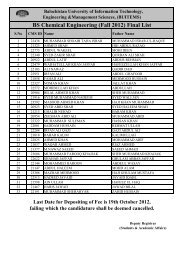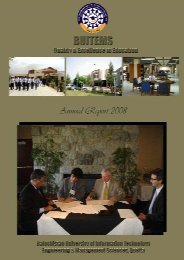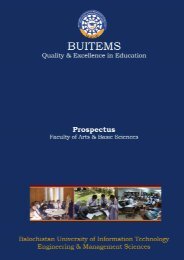BUITEMS
Research Journal - buitems
Research Journal - buitems
- No tags were found...
Create successful ePaper yourself
Turn your PDF publications into a flip-book with our unique Google optimized e-Paper software.
<strong>BUITEMS</strong><br />
Quality & Excellence in Education<br />
Orange Peel as an Adsorbent for the Removal of Reactive Blue Dye<br />
from Textile Waste Water<br />
Nazakat Ali * and Noor Ahmed<br />
Department of Textile Engineering, Balochistan University of Information Technology, Engineering &<br />
Management Sciences, Quetta<br />
Abstract<br />
In this study the capable use of the low cost and eco-friendly material orange peel as a biosorbent<br />
for the removal of dichlorotriazine Reactive Blue (RB-Drimarine-K2 RL) dye from aqueous<br />
solutions was studied, containing equilibrium and dynamic studies. Experiments were performed<br />
on different dye concentrations, particle sizes, adsorbent doses, pH, shaking speed and shaking<br />
time. It was revealed that the adsorption capacities of orange peels were comparatively high for<br />
the reactive dyes. The adsorption equilibrium data could be best plotted by applying the Langmuir<br />
and Freundlich isotherms. The experimental results were labeled by both isotherm. Adsorption<br />
results were analyzed using the linear models and the regression results showed that the<br />
adsorption was more accurately described by a Lngumuir model.<br />
Key words: Reactive Blue (RB), Dicholortiazine (DCT), Monochlorotriazine (MCT), adsorption.<br />
*<br />
Corresponding Author’s email: nazakat.ali@buitms.edu.pk<br />
INTRODUCTION<br />
The textile industry is one of the largest<br />
production industries, having significant role<br />
in manufacturing sector global industry. It<br />
provides enormous masses of materials for<br />
clothing and furnishings, with their specialties<br />
and end-uses (Broadbent, 2001). The dyeing<br />
procedures may be divided into two major<br />
classes of immersion exhaustion (exhaust<br />
dyeing) and pad impregnation (pad dyeing)<br />
processes (Khatri, 2010). The degree of<br />
fixation is variable in different classes of dyes;<br />
the reactive dye has 50-80% of fixation, the<br />
remaining components are unfixed dyes. The<br />
dyeing process produces huge amount of<br />
colored wastewater; the amount of color pick<br />
up varies from material to material and<br />
amount of dye to be hydrolyzed in water. The<br />
wet pick up for polyester cotton blends for<br />
reactive dyes is 40-45% and it is 60-70% for<br />
cotton, cellulosic fibers, the remaining<br />
amount of unfixed hydrolyzed disposed in<br />
water streams (Broadbent, 2001). The<br />
reactive dyes react with hydroxide ions<br />
present in the aqueous dyebath under<br />
alkaline pH conditions. This produces<br />
nonreactive hydrolysed dye which remains<br />
in the dyebath as well as in the fiber. In order<br />
to obtain the required levels of washing<br />
fastness, it is necessary to remove all<br />
unreacted and hydrolysed (unfixed) dye from<br />
the cotton fiber. This is achieved by ‘washingoff’;<br />
a series of thorough rinsing and ‘soaping’<br />
steps. The dye fixation efficiency is typically<br />
in the range of 50–80%; i.e. 20 to 50% of the<br />
dye of the desired shade of color is<br />
discharged to the environment. (Khatri,<br />
2010). Irrespective of the dyeing method and<br />
the type of reactive group, almost all of the<br />
potentially toxic non biodegradable inorganic<br />
electrolyte, alkali and unfixed dye are<br />
discharged to dyeing effluent. This creates<br />
potential environmental problems from a<br />
highly-colored effluent with high levels of<br />
dissolved solids and oxygen demand. (Khatri<br />
, 2010). There are different conventional<br />
methods available for the treatment of such<br />
industrial waste; physical, chemical, physicochemical,<br />
biological, and membrane<br />
technology are the methods that are widely<br />
used for the control of these effluents.<br />
Adsorption is one of the best methods for the<br />
removal or reduction of dye containing water<br />
effluents. Amongst all the sorbent materials<br />
47
















